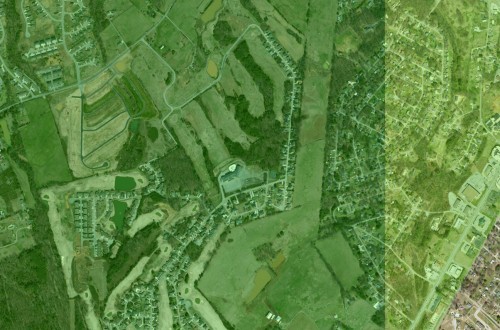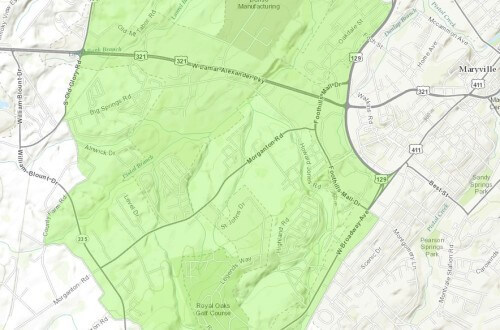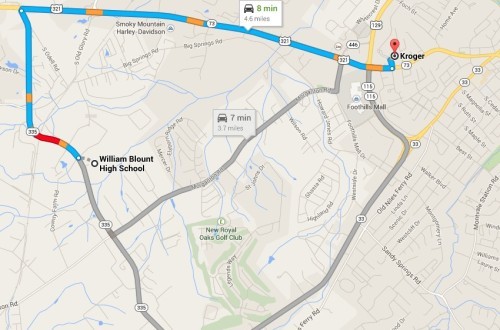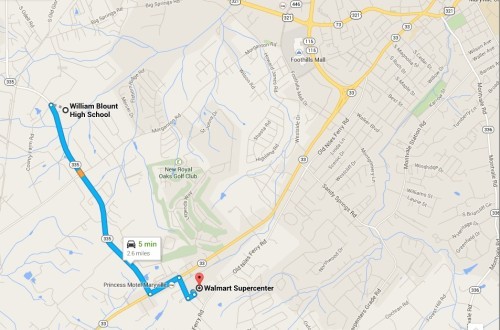Ricochet is the best place on the internet to discuss the issues of the day, either through commenting on posts or writing your own for our active and dynamic community in a fully moderated environment. In addition, the Ricochet Audio Network offers over 50 original podcasts with new episodes released every day.
 The Mirages In Your Local Food Desert
The Mirages In Your Local Food Desert
 James Lileks’ Bleat this morning got me thinking about this “food desert” idea that the First Lady has been talking about. Instapundit had a funny comment about grocery shopping in his local Federally-designated food desert the other day, which was the first I’d heard of the USDA’s interactive map of our produce-free arid zones. Well, I decided to check out the local food deserts for myself. Looking first in my home county (Blount County, Tennessee), I was shocked to find a giant food desert right at the doorstep of my church! In fact, our old sanctuary building is inside the desert, although the new one across the street has escaped this lack of privilege. If you look at the first satellite map, the green region is our food desert. What are the red circles I’ve added, you’re wondering? Don’t get ahead of me, now.
James Lileks’ Bleat this morning got me thinking about this “food desert” idea that the First Lady has been talking about. Instapundit had a funny comment about grocery shopping in his local Federally-designated food desert the other day, which was the first I’d heard of the USDA’s interactive map of our produce-free arid zones. Well, I decided to check out the local food deserts for myself. Looking first in my home county (Blount County, Tennessee), I was shocked to find a giant food desert right at the doorstep of my church! In fact, our old sanctuary building is inside the desert, although the new one across the street has escaped this lack of privilege. If you look at the first satellite map, the green region is our food desert. What are the red circles I’ve added, you’re wondering? Don’t get ahead of me, now.
The definition of a food desert on the USDA map is a census zone with both Low Income (“LI”) and Low Access (“LA”) to nutritious food. Now, the trick with a survey of this type is how these things are defined:
- Low Income is a tract with either a poverty rate ≥20%, or a median family income <80% of the state or region’s.
- Low Access is a tract in which either ≥500 people or 1/3 of the population live too far from a supermarket. Too far is different for urban and rural areas: >1 mi. for urban and >10 mi. for rural.
OK, with that in mind, let’s look at Blount County’s desert of shame. Remember the red circles I drew? Those are grocery stores. The one just outside the east end is Kroger’s, but it’s outside the desert, so maybe it doesn’t count. The other one is a Wal-Mart Superstore, and it’s inside the desert. So how does this area classify as Low Access? Ahh, but this tract is classified as “urban.” Let’s take a closer look at the denser portion of it, near the southern end.

Does that look urban? Don’t laugh — next to the farm there is a dense clustering of houses surrounding the golf course! Now, as a farm boy, I find all of this is too urban for me, but I doubt it would strike most people that way.
Since it’s “urban” and “low-income” (The golf course community isn’t the only neighborhood here—there are some poorer spots here and there), there must be a “supermarket” within one mile. So why isn’t there a gap a mile wide around each of the grocery stores here? Because the USDA is measuring the distances from the “centroid” (think center-of-gravity) of the census tract. Since that is farther than one mile from the stores, the whole tract is counted as too far from a store.
Here is another reason the approach doesn’t make sense to me: Why are there different distance criteria for “urban” and “rural” zones? If a country boy like me has “access” to a store within 10 miles, why is a city slicker restricted to traveling only one mile? I suspect it comes from the truly urban mindset that you don’t use a car to get anywhere and that a mile is as far as you care to walk.
But is that reasonable? Look again at this “urban” zone. Where do you think you’ll get on foot? To work? To school? Church? Everybody has a car. I looked up the statistics with the same USDA map: there are 7,915 people in this tract, grouped into 3,238 “housing units.” Of these, 51 housing units have no “vehicle access.” That’s 1.6% of the houses without “access” to a car. We don’t have buses here, and those few without vehicle access aren’t going to get anywhere by walking, so somebody has to give them a ride to get to work or school unless they’re an elderly shut-in who rarely leaves the house. In that case, I guarantee someone is helping bring groceries too. It’s not like these people are able to walk to a 7-11 and stock up on Cheetos. They’re being driven to get food.
Now that we’ve established that nearly everybody has a car — and even more have access to a car — how hard are those grocery stores to get to?
Here is an overview of the streets. William Blount High School, in the far western edge, is the most remote part of the tract.

If you want to go to Kroger, Google Maps says it’s 3.7 miles away and will take you 7 minutes.

Or, if you decide that’s too awfully hard for you to access, you can just go to Wal-Mart, which will take you…5 minutes to drive the 2.6 miles.

Whoop-tee-do.
Here’s my take on the whole project:
- The distinction between “urban” and “rural” is pointless. If people truly don’t have access to cars or buses, do they walk everywhere? Those are the only people for whom a neighborhood grocery store is necessary. This study blatantly ignores the rate of car ownership.
- If people have cars, look at the driving time, not the distance. My family drove halfway across the county to go grocery shopping. Even starting in town, you get to a bigger road and can go pretty far in just a few minutes.
- The use of census tracts and their centroids is crude. It makes you do dumb things like draw a food desert with a grocery store in it. I’m sure this made it easier for them to do the study, but their results don’t match their claims.





Good article, Tim. Is somebody actually asking for something to be done about these phoney food deserts? What do they want, federal grocery stores every half mile? Or is this a make-work project because we have more federal employees that we need?
One more thing came to mind about the way this study is set up. Why are there two possible criteria for “Low Access”? It’s either ≥500 people or ≥1/3 of the tract’s population. If all census tracts had about 1,500 people, so that 500 represented 1/3, then the alternatives would be equivalent.
But in the tract I’ve studied, there are 7,915 people. 500 people represent just 6.3% of the tract population! The only thing that makes sense to me is a straight percentage of the population. Having that 500-person floor makes your interpretation depend on however the census tracts are set up.
I’m sure that’s all coming next. :)
OK, I’ve finally figured out the image loading, and they should appear now.
Randy Weivoda:
Hmm…I didn’t think to ask what the point was. Well, let’s see—what is the USDA pushing with this? Ohhhh, I see: There is Federal grant money available to solve the problem!
I especially like the question, “I do not know my census tract code. How do I know if I’m in a Food Desert?” You know, I ask myself that every morning.
This would make a great parody of one of those online “privilege” questionnaires, wouldn’t it? “I had no idea I was unprivileged, until I looked up my census tract code and discovered I was in a Food Desert!”
I live in downtown Pittsburgh. There is no proper grocery store within the Golden Triangle.
The first question I’m always asked by suburbanites when they find out I live downtown is “Where do you get your groceries?”
My answer is “At the grocery store.” There must be 15 within a 10 minute radius of my home. I just pick one and drive to it like everyone else.
I’ve never been able to understand why suburbanites think city livers need immediate access to grocery stores when they themselves do not. The 1 mile cutoff is ridiculous.
I used to live in Knoxville, and even if you lived within a mile of a grocery store you still probably drove. Only people who live in densely packed cities and live like Europeans (like buying groceries in small batches) seem to think this way. It’s the same sort of people that have the mentality that gas should be $9 a gallon because it doesn’t affect them in the least, they don’t drive and assume everybody is like them.
(edit: Ok, it does affect them in the price of practically everything else, but lefties don’t seem to be good at connecting those kind of dots.)
How can you possibly eat?! Heh, heh…yeah, I know the spot. I lived in Pittsburgh for grad school and for a bit when we first got married.
Wait ’til the USDA ponders this thing called the Strip District. I wonder if any of the stores there would even qualify as “supermarkets” under the Food Desert criteria. Some of the criteria I read online (not necessarily USDA) were restricted to stores with ≥20 employees, so probably nothing in the Strip District will show up, despite the enormous variety of food and groceries available.
How about the surprising revival of East Liberty? I lived in Shady Side during grad school, right across the East Busway from East Liberty. That used to be a place to get shot on a weekend, and I did hear gunfire once. When we got married, we were in Shady Side again, but East Liberty had added a Borders, wine shop, and the Giant Eagle expanded and bragged about their 400 varieties of cheese! Now there’s a condo, too, but it says it’s “in Shady Side.” (Who believes that?)
Now that I think about it, let me also add that there are multiple CVSs, 7-11s, and Rite Aids, a couple little grocers/newstands, and the Strip District which is probably right at the 1 mile cutoff from my front door.
Isn’t the problem that we all have too much access to food and we’re all obese?
Tim, your credibility has gone through the roof with me.
That East Liberty area is a great example. A lot of poor areas that might be just beyond the one mile cutoff but are easily accessible by bus. A Target, Whole Foods, Trader Joe’s, and Giant Eagle all within a half mile stretch.
Oh but that’s gentrification. The problems are endless!
I think the “food desert” idea is part of the slow food movement. Like anything lib, they start with an unsubstantiated conclusion that fits their feelings and then make up the data to support it. Hence, the nonsensical requirements to found a “food desert” that includes a grocery store!
Slowfoodusa.org
Read if you must but do so without sharp objects within reach.
Thanks, man! I do try…
See, the problem is that for all their hand-wringing, hunger is not a problem in the US. It’s definitely not a problem like in third world countries where poverty means a day-to-day struggle for survival. No, hunger is nigh non-existent. So they make up data and categories.
Remember the statistic that said something like 1 in 4 children in America go hungry? That was based off a statistic that asked if they ever missed a meal in the last year. As a teen, I often skipped meals because that’s part of the stupid decision-making teens do. Apparently that made me a statistic.
There’s also “Food Insecurity”. They aren’t going hungry, but they don’t know where their next meal is coming from. Seriously, that’s a Thing. It’s something we’re supposed to be horridly worried.
Essentially, rather than admit that hunger in America is generally based on one’s individual and familial lifestyle choices, we have to create new definitions to make it sound as if we’re always on the brink of starvation.
Once again, lies, damn lies, and statistics.
For what it’s worth, I checked out the interactive map and learned that one major “Food Desert” in Our Fair City has a large, well-established grocery store. And about three or more large grocery stores are situated right across a street from a “Food Desert.”
According to the map, I suffer greatly because I live in a low-income neighborhood more than a mile from a grocery store. While it’s true that my neighborhood is probably classified as low-income, I regularly walk to the store that’s three short blocks away (maybe a quarter of a mile).
I was also surprised to discover that the area of the City where many tenured and well-compensated college professors live is also considered “low income.” Perhaps the BMWs in their driveways are more than a year old. How sad.
We have basically eliminated hunger in America, so the left has to come up with “Food Insecurity” and “Food Deserts” so that they can still make those appeals for More Government Funding! (i.e., higher taxes on the evil rich.)
It’s the same reason that every time you question whether unions are necessary, it suddenly becomes 1911, and the Triangle Shirtwaist Factory Fire just happened.
More than that, by instilling a fear of impending hunger, it gives Progressives one more excuse to further Government control over us. To the Progressive, we need food programs for kids (and who knows, maybe later for adults too) because with Government these kids don’t know where their next meal is, it’s certainly not a mile away from where they live. Where can they go? WON’T SOMEONE THINK OF THE CHILDREN?
And so Progressives further undermine the family unit as the provider and nurturer of children and replace it with a large government bureaucracy.
I didn’t eat breakfast, I forgot my lunch, and after work I’ve gotta coach T-ball. I won’t have my first meal until 7:30 tonight.
Why doesn’t somebody do something about this!?
Like.
This makes me start thinking about my next meal. Great. Now you’ve gone and made me hungry!
Casey, I count 19 government grant opportunities available for you to apply for and fix this problem of your food insecurity. I think the most appropriate one for your situation is the “Healthy Urban Food Enterprise Development Center (HUFED).” I understand that HUFED is especially good when you’re hungry for three little pigs, but to be even more secure, you should double up with an application to PUFED (Piggy Under-Fed Emergency Dinner). These can be warmed up any time for your on-the-go lifestyle.
Already here, guys. Recommendations from the 2009 report to congress include luring big-box discount stores to the desert. Of course, when they did that in DC with Wal-mart the city council tried to pass a low requiring a wal-mart specific minimum wage. Other suggestions included using welfare EBT at farmer’s markets for fresh produce (taxes already supporting that now), improved public transportation, and changing SNAP regulations to require more fresh and healthy products for sale. But wait there’s more….local government should include food accessibility in urban planning and because poverty is positively correlated with food deserts, more spending on anti-poverty programs is needed.
Mostly just more spending is needed. Even after a really nice study came out in 2012, that was unsupportive of many of the food desert assumptions, the NYT continued to say poverty is the key problem and we need more money for anti-poverty programs.
It’s nice when you have the same answer to every question, isn’t it ?
The green areas are the designated “Food Deserts” in Our Fair City. The large red dots are large grocery stores. The small blue dots are small grocery stores or convenience stores with groceries. (I inserted as many as I could think of, guaranteed I missed several.) The pink circles delineate a 1-mile radius around the large grocery stores.
Oops. I forgot the K-Mart and the ShopKo, which also have groceries. Also not shown: a crapload of restaurants and fast-food places.
Food Deserts look like abundance to me!
Drew, what software did you use to annotate your map? I like how that came out, and I’d like to try the same thing.
Man, why can’t they denote “Food Desserts”? Because I could really go for a slice of pie right now.
Thanks for posting this. I managed to crash the map software when I was trying to look it up myself. I’ve got no one to blame but myself, living in a notable technology desert.
I should note that, as it sits right now, I live in the lush, verdant oasis north of the map. To get my groceries I regularly travel down, into the the desert to the grocery store Drew pointed out. It’s a regular caravan of silks from Samarkand, I tell you.
I, . . . uh, did a screen shot of the map, and then added the dots and circles with Photoshop. I’m fiddly that way. I also love making maps.
Hilarious! If you zoom out a bit, there’s a “Food Desert” right across the Chippewa County line (encompassing the neighborhoods around the airport and the Lake Hallie Golf Course) that reaches almost all the way up to the Super Wal-Mart in Hallie. (Where, you guessed it, groceries are readily available at low prices.)
On one hand, it’s not ridiculous if you don’t have a car.
On the other hand, the point is well-taken, the “food desert” meme is ridiculous.
On the third hand, the attached image [or, the image that would have been attached if Ricochet weren’t having some kind of media-refusing fit right now] shows most of the south side of Chicago being a food desert of one kind or another.
Why is that? Because the unions, with the assistance of community organizers and a complaisant city council REFUSE to let Wal-Mart open stores in the city limits. Jobs be damned, food desert be damned, tax revenue be damned.
I had something on this at the Bleat today. Fargo’s big food desert is an airport.
I believe the “food” the government is referring to in their “food desert” is fresh produce. Schools are having a hell of a time persuading kids to eat “healthy” food, and finding much of Moochelle’s mandated lunch offerings going in the garbage. The people who complain about lack of suitable food choices in certain neighborhoods are NOT the people who live in those neighborhoods. I guess I live in a “food oasis”, since the local Costco is 6 blocks away, and a nice big “discount” grocery store just moved in across the street from the entrance to my neighborhood.